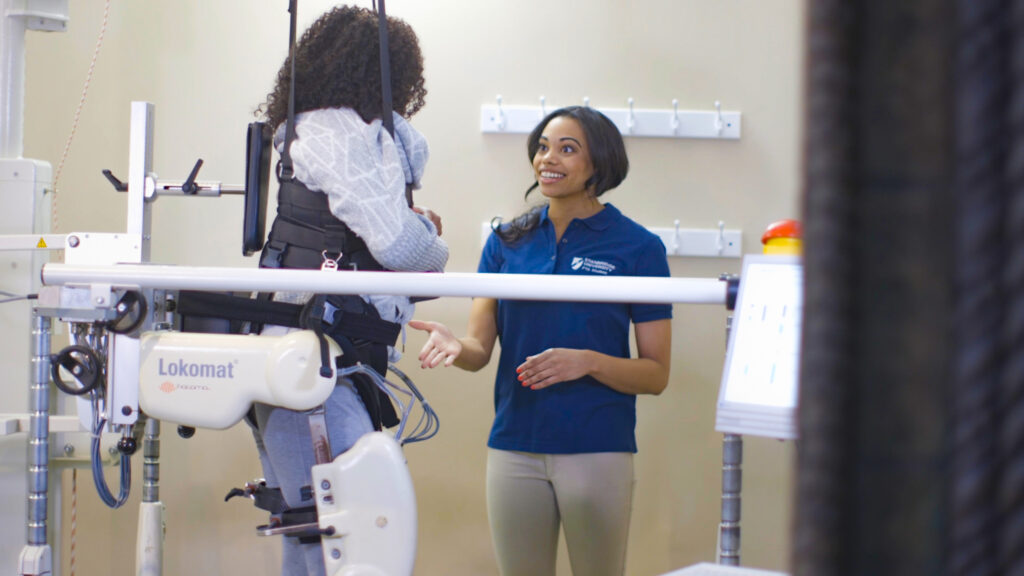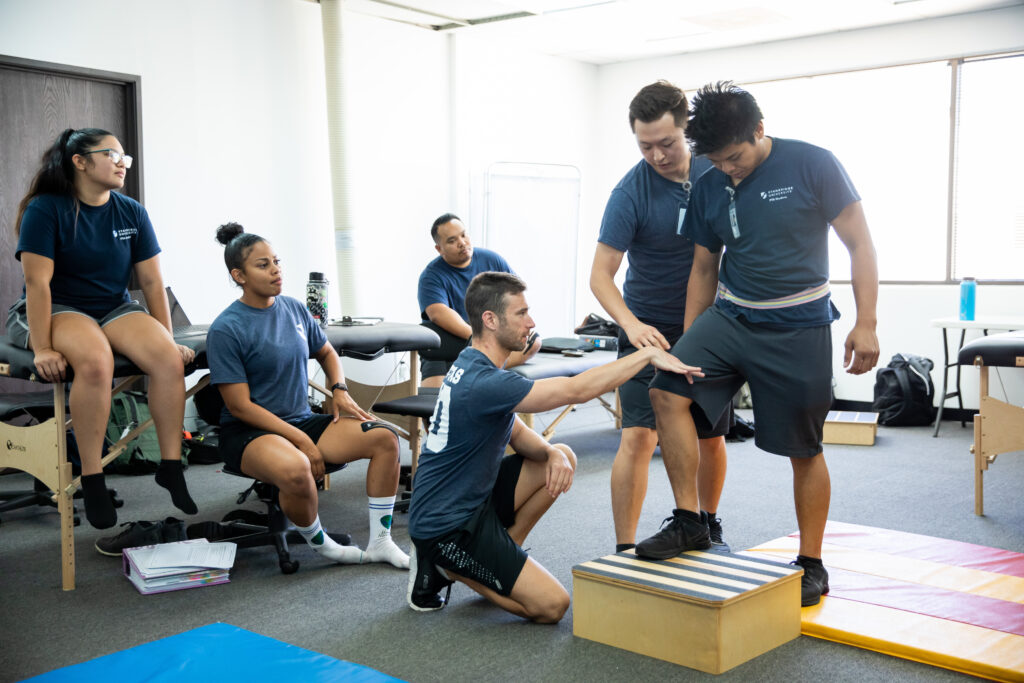Your Timeline to a PTA Career: How Long It Really Takes

Thinking about a hands-on career in healthcare? Becoming a physical therapist assistant (PTA) might be the right path for you. After graduation, you’ll take the National Physical Therapy Exam (NPTE) and apply for state licensure.¹ Most students can complete an accredited associate degree program in about two years¹( 20–21 months at Stanbridge University),² gaining both classroom knowledge and clinical experience. The journey may be shorter than you expect, and it offers the opportunity to help patients work toward improved strength, confidence, and independence.
Learning how to become a physical therapist assistant starts with one simple motivation: a desire to help people move, heal, and live better. PTAs play a key role in rehabilitation, specifically working directly with patients to help restore mobility and confidence after injuries or illness.¹
In contrast to many healthcare careers that take years of advanced study, the PTA path is focused, accessible, and full of impact. During the course of the program, you’ll learn how to support licensed physical therapists to guide patients through recovery.¹
In this guide, we’ll explore what a PTA does, how long it takes to earn your degree, and what sets this career apart in the world of physical therapy.
What Does a Physical Therapist Assistant Do?
Physical therapist assistants work under the supervision of licensed physical therapists (PTs).¹ Their role combines skill, compassion, and teamwork.
Each day, PTAs:
- Guide patients through exercises and stretches.¹
- Apply treatments like heat, cold, or electrical stimulation.¹
- Track progress and report changes to the supervising PT.¹
- Motivate patients to reach their therapy goals.¹
PTAs often work in hospitals, outpatient clinics, rehabilitation centers, and nursing care facilities.¹ No two days look the same; every day offers a chance to make a difference.

How to Become a Physical Therapist Assistant
The journey to becoming a licensed physical therapist assistant includes several key steps:
- Complete an accredited associate degree program.¹
Programs like the Associate of Science in Physical Therapist Assistant offered by Stanbridge University combine classroom learning, labs, and clinical practice. The Physical Therapist Assistant program at Stanbridge University is accredited by the Commission on Accreditation in Physical Therapy Education (CAPTE), ensuring that students receive high-quality instruction that meets national professional standards. - Gain hands-on experience through clinical rotations.¹
Students work in healthcare environments, guided by experienced clinicians. The experience builds confidence and prepares them for patient care. - Pass the National Physical Therapy Exam (NPTE).³
The national exam ensures that graduates are ready to provide safe, effective care. Stanbridge University’s Physical Therapist Assistant (PTA) program consistently demonstrates exceptional outcomes, with graduates achieving a 100% ultimate pass rate and a 98.6% first-time pass rate at the Orange County campus, and a 100% ultimate pass rate with a 91.2% first-time pass rate at the Los Angeles campus between 2022 and 2023.⁴ - Apply for state licensure.¹
Each state has its own process. Once you’re licensed, though, you’re officially ready to begin your PTA career.
Each step builds your skills and prepares you for a meaningful future in physical therapy.
How Long Does It Take to Become a Physical Therapist Assistant?
Most PTA programs take around two years to complete.¹ With that said, Stanbridge University’s PTA program takes about 20–21 months, including holidays and term breaks.²
During this time, you’ll study anatomy, physiology, kinesiology, and patient care. Along with that, you’ll also take part in clinical practicums where you apply what you’ve learned directly with patients.
What’s the Difference Between a Physical Therapist, Aide, and Assistant?
It’s easy to confuse the different roles in physical therapy, but here’s how they differ:
- Physical Therapist (PT): PTs hold a Doctor of Physical Therapy (DPT) degree and create treatment plans for patients.⁵
- Physical Therapist Assistant (PTA): PTAs earn an associate degree and are licensed to carry out therapy exercises and treatments under a PT’s supervision.¹
- Physical Therapy Aide: Unlike the other two, aides typically only need a high school diploma. They assist with tasks like cleaning equipment and preparing treatment areas. However, they are not licensed to treat patients.¹
All three roles are important, but PTAs bridge the gap between the PT’s plan and the patient’s progress.
Career Outlook for Licensed PTAs
According to the California Employment Development Department (EDD), employment for PTAs is projected to grow by 41.8% from 2022 to 2032, with an estimated 16,210 total job openings during that period.⁶ This strong outlook reflects the ongoing need for rehabilitation and mobility services as California’s population ages and healthcare access expands. PTAs can expect steady opportunities across hospitals, clinics, nursing care facilities, and home health services.
The Takeaway: A Fast Track to a Meaningful Career
So, how to become a physical therapist assistant? The process usually takes about two years and includes coursework, labs, clinical training, and licensure.¹ Along the way, you’ll build both technical and personal skills, like communication, empathy, and problem-solving, that prepare you to help patients thrive.¹ Ultimately, if you’re ready to start a career that combines science, compassion, and movement, the PTA path could be your next step forward.
Wondering what it takes to become a physical therapist assistant? Explore the Physical Therapist Assistant (PTA) program to learn more about how Stanbridge University provides coursework, labs, and clinical training that support students in preparing for licensure and practice. You can also connect with our admissions team for one-on-one guidance as you take the next step toward your career in physical therapy.
Stanbridge University Recognition and Awards
Stanbridge University offers healthcare degree programs across its Southern California campuses in Irvine, Alhambra, Riverside, and San Marcos. The university has been recognized for both academic excellence and workplace culture, including recognition in the 2025 Carnegie Classifications as an Opportunity College⁷ and in Research.com’s 2024 Best Healthcare Degree Programs in America.⁸
Its Orange County campus earned the 2024–2025 ACCSC School of Excellence Award,⁹ and in 2025, Georgetown University’s Center on Education and the Workforce ranked Stanbridge among the top 5% of U.S. colleges for 10-year return on investment, based on earnings and tuition data from qualifying programs.¹⁰
Frequently Asked Questions
Most PTA programs take around two years to complete.¹ With that said, Stanbridge University’s PTA program takes about 20–21 months, including holidays and term breaks.²
To become a licensed physical therapist assistant, you’ll first need to complete an accredited PTA program. After graduation, you must pass the National Physical Therapy Exam (NPTE) and apply for state licensure. Once licensed, you’ll be qualified to work under the supervision of a physical therapist in hospitals, outpatient clinics, and rehabilitation centers.¹
The main difference is in education and responsibility. A physical therapist (PT) holds a doctoral degree and designs patient treatment plans.⁵ A physical therapist assistant (PTA) holds an associate degree and works directly with patients to carry out those treatment plans.¹ A physical therapy aide, on the other hand, typically needs only a high school diploma and supports the therapy team with basic tasks, such as setting up equipment and preparing treatment areas.¹
A successful PTA combines technical knowledge with strong personal skills. In addition to understanding anatomy, physiology, and patient care, you need excellent communication, empathy, and problem-solving abilities to motivate patients and help them thrive during their recovery.¹
Yes, the role of a PTA can be physically demanding as it requires hands-on interaction with patients. Daily responsibilities include guiding patients through exercises, applying treatments, and helping them move, all of which require physical stamina and strength.¹
Footnotes
¹Source: Bureau of Labor Statistics, U.S. Department of Labor, Occupational Outlook Handbook, Physical Therapist Assistants and Aides, https://www.bls.gov/ooh/healthcare/physical-therapist-assistants-and-aides.htm. As viewed on October 14, 2025.
²Program duration subject to change. Completion times vary depending on the start and end dates of a cohort and individual progression.
³Source: American Physical Therapy Association, About the National Physical Therapy Examination, https://www.apta.org/your-practice/licensure/national-physical-therapy-examination. As viewed October 14, 2025.
⁴Source: National Physical Therapy Exam (NPTE) for PTA Ultimate and First-Time Pass Rates for graduates, 2018/2019–2022/2023, Orange County and Los Angeles campuses; The Federation of State Boards of Physical Therapy; Basic Pass Rate Report. As viewed on October 14, 2025.
⁵Source: Bureau of Labor Statistics, U.S. Department of Labor, Occupational Outlook Handbook, Physical Therapists, https://www.bls.gov/ooh/healthcare/physical-therapists.htm. As viewed on October 14, 2025.
⁶Source: California Employment Development Department (EDD), Occupation Profile – Physical Therapist Assistants (SOC Code: 31-2021), California, 2024 Q1 Employment Projections (2022–2032), California Labor Market Info. As viewed on October 14, 2025.
⁷Source: Carnegie Classifications. As viewed on May 21, 2025.
⁸Source: Research.com, 2024 Best Healthcare Degree Programs Ranking in America. https://research.com/rankings/healthcare/best-healthcare-usa/?award=f3d66c8ef200b579. Email communication from Chief Data Scientist and Ranking Editor, Imed Bouchrika, Ph.D. to Director of Marketing, Victoria Sauer. As viewed on December 12, 2024.
⁹Source: Stanbridge University, Orange County campus, Accrediting Commission of Career Schools and Colleges (ACCSC) School of Excellence 2025 Award. Email communication from Michelle Ragland, Member Services and Events Manager, ACCSC, to Director of Marketing, Victoria Sauer. As viewed on July 17, 2025.
¹⁰Source: Georgetown University’s Center on Education and the Workforce. As viewed on March 19, 2025.
